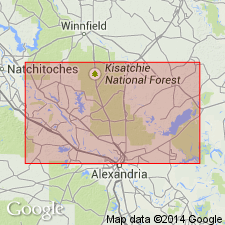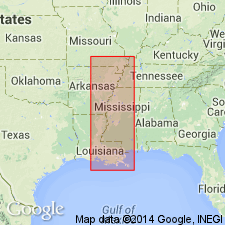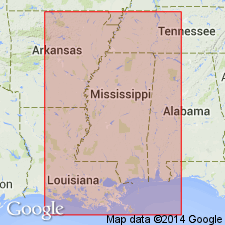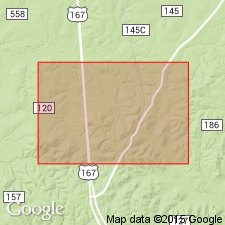- Usage in publication:
-
- Danville Landing group
- Danville Landing beds
- Modifications:
-
- Original reference
- Dominant lithology:
-
- [Sand]
- [Clay]
- AAPG geologic province:
-
- Arkla basin
Hanna, M.A., and Gravell, Donald, 1934, [Chart and discussoin] IN McGuirt, James, Bryozoa of the upper and lower Chickasawhay members of the Catahoula formation of Wayne County, Mississippi: Shreveport Geological Society Guidebook, Annual Field Trip, no. 11, p. 28+.
Summary:
[Danville Landing group; Danville Landing beds. Synonymous terms applied to uppermost part of Jackson formation of Louisiana and Mississippi by M.A. Hanna, D. Gravell, and J. McGuirt (11th Ann. Field Trip Shreveport Geol. Soc., 1934, table opp. p. 30, p. 35-37). Not described, but said to "correspond to Cocoa sand of Cushman and to be younger than typical Cocoa sand. Said to overlie Yazoo "group," but apparently the beds were in previous reports included in Yazoo of Mississippi. Fossils mentioned. Danville Landing is said to be on Ouachita River in Catahoula Parish, Louisiana.]
Source: US geologic names lexicon (USGS Bull. 896, p. 572).

- Usage in publication:
-
- Danville Landing beds
- Modifications:
-
- Areal extent
- Dominant lithology:
-
- Sand
- Clay
- AAPG geologic province:
-
- Arkla basin
Summary:
Pg. 106. Danville Landing beds. Present in Grant and La Salle Parishes, central Louisiana, as a 40-foot series of interbedded sands and clays. Grade vertically into underlying Verda member (new) of Yazoo formation and into overlying gypsiderous clays of Vicksburg group. [Age is Eocene.]
Source: US geologic names lexicon (USGS Bull. 1200, p. 1043).

- Usage in publication:
-
- Danville Landing beds
- Modifications:
-
- Revised
- AAPG geologic province:
-
- Arkla basin
Summary:
Pg. 13 (table 2), 14, 15. Jackson group divided into three formations (ascending): Moodys Branch marl, Yazoo clay, and Danville Landing beds. [Age is Eocene.]
Source: US geologic names lexicon (USGS Bull. 1200, p. 1043).

- Usage in publication:
-
- Danville Landing formation
- Modifications:
-
- Areal extent
- AAPG geologic province:
-
- Arkla basin
Summary:
Pg. 1838 (fig. 6), 1839. Danville Landing formation present above Yazoo clay in central Louisiana. In Jackson group. [Age is Eocene.]
Source: US geologic names lexicon (USGS Bull. 1200, p. 1043).

- Usage in publication:
-
- Danville Landing formation (beds)
- Modifications:
-
- Areal extent
- AAPG geologic province:
-
- Arkla basin
Summary:
Pg. 702 (fig. 1), 703, 704, 705. Danville Landing formation (beds) underlies Mosley Hill formation (new). [Age is late Eocene.]
Source: US geologic names lexicon (USGS Bull. 1200, p. 1043).
For more information, please contact Nancy Stamm, Geologic Names Committee Secretary.
Asterisk (*) indicates published by U.S. Geological Survey authors.
"No current usage" (†) implies that a name has been abandoned or has fallen into disuse. Former usage and, if known, replacement name given in parentheses ( ).
Slash (/) indicates name conflicts with nomenclatural guidelines (CSN, 1933; ACSN, 1961, 1970; NACSN, 1983, 2005, 2021). May be explained within brackets ([ ]).

